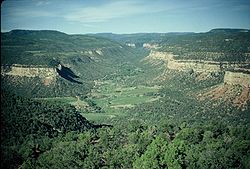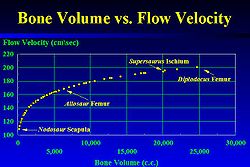
Dry Mesa Quarry
Encyclopedia

Colorado
Colorado is a U.S. state that encompasses much of the Rocky Mountains as well as the northeastern portion of the Colorado Plateau and the western edge of the Great Plains...
, USA, near the town of Delta
Delta, Colorado
The City of Delta is the county seat and the most populous city of Delta County, Colorado, United States. The population was 8,915 at the 2010 census...
. Its geology forms a part of the Morrison Formation
Morrison Formation
The Morrison Formation is a distinctive sequence of Late Jurassic sedimentary rock that is found in the western United States, which has been the most fertile source of dinosaur fossils in North America. It is composed of mudstone, sandstone, siltstone and limestone and is light grey, greenish...
and has famously yielded a great diversity of animal remains from the Jurassic
Jurassic
The Jurassic is a geologic period and system that extends from about Mya to Mya, that is, from the end of the Triassic to the beginning of the Cretaceous. The Jurassic constitutes the middle period of the Mesozoic era, also known as the age of reptiles. The start of the period is marked by...
Period, among them Ceratosaurus
Ceratosaurus
Ceratosaurus meaning "horned lizard", in reference to the horn on its nose , was a large predatory theropod dinosaur from the Late Jurassic Period , found in the Morrison Formation of North America, in Tanzania and Portugal...
, Supersaurus
Supersaurus
Supersaurus is a genus of diplodocid sauropod dinosaur discovered by Vivian Jones of Delta, Colorado, in the Upper Jurassic Morrison Formation of Colorado in 1972. The fossil remains came from the Brushy Basin Member of the formation, dating to about 153 million years ago...
, and Torvosaurus
Torvosaurus
Torvosaurus is a genus of large theropod dinosaur that lived during the Late Jurassic period...
. The quarry is found within the Uncompahgre National Forest
Uncompahgre National Forest
Uncompahgre National Forest is a U.S. National Forest covering 955,229 acres in parts of Montrose, Mesa, San Miguel, Ouray, Gunnison, San Juan, and Delta Counties in western Colorado...
.
History
In 1971, a large theropod phalanxPhalanx bones
In anatomy, phalanx bones are those that form the fingers and toes. In primates such as humans and monkeys, the thumb and big toe have two phalanges, while the other fingers and toes consist of three. Phalanges are classified as long bones.The phalanges do not have individual names...
(Torvosaurus
Torvosaurus
Torvosaurus is a genus of large theropod dinosaur that lived during the Late Jurassic period...
tanneri) http://dinosaurjim.com/html/torvosaurus_tanneri.html was discovered at Dry Mesa by Daniel and Vivian Jones http://dinosaurjim.com/html/eddie___vivian_jones.html of Delta, Colorado. The find was reported to James A. Jensen
James A. Jensen
James A. Jensen , was an American paleontologist. His extensive collecting program at BYU in the Utah-Colorado region which spanned 23 years was comparable in terms of the number of specimens collected to that of Barnum Brown during the early 20th century. He was given the name "Dinosaur Jim"...
http://dinosaurjim.com/html/dry_mesa_quarry.html of Brigham Young University
Brigham Young University
Brigham Young University is a private university located in Provo, Utah. It is owned and operated by The Church of Jesus Christ of Latter-day Saints , and is the United States' largest religious university and third-largest private university.Approximately 98% of the university's 34,000 students...
(BYU) who commenced quarrying operations in 1972. Under the direction of the BYU Earth Science Museum, the quarry has been excavated for 13 field seasons. Approximately 4000 bones have been collected, making it one of the most prolific dinosaur producing accumulations in the Morrison Formation
Morrison Formation
The Morrison Formation is a distinctive sequence of Late Jurassic sedimentary rock that is found in the western United States, which has been the most fertile source of dinosaur fossils in North America. It is composed of mudstone, sandstone, siltstone and limestone and is light grey, greenish...
. Thirty vertebrate
Vertebrate
Vertebrates are animals that are members of the subphylum Vertebrata . Vertebrates are the largest group of chordates, with currently about 58,000 species described. Vertebrates include the jawless fishes, bony fishes, sharks and rays, amphibians, reptiles, mammals, and birds...
genera
Genera
Genera is a commercial operating system and development environment for Lisp machines developed by Symbolics. It is essentially a fork of an earlier operating system originating on the MIT AI Lab's Lisp machines which Symbolics had used in common with LMI and Texas Instruments...
are represented in the quarry including dinosaur
Dinosaur
Dinosaurs are a diverse group of animals of the clade and superorder Dinosauria. They were the dominant terrestrial vertebrates for over 160 million years, from the late Triassic period until the end of the Cretaceous , when the Cretaceous–Paleogene extinction event led to the extinction of...
s, a pterosaur
Pterosaur
Pterosaurs were flying reptiles of the clade or order Pterosauria. They existed from the late Triassic to the end of the Cretaceous Period . Pterosaurs are the earliest vertebrates known to have evolved powered flight...
, crocodile, turtle, lungfish
Lungfish
Lungfish are freshwater fish belonging to the Subclass Dipnoi. Lungfish are best known for retaining characteristics primitive within the Osteichthyes, including the ability to breathe air, and structures primitive within Sarcopterygii, including the presence of lobed fins with a well-developed...
, and a prototheria
Prototheria
Prototheria is a taxonomic group, or taxon, to which the order Monotremata belongs. It is conventionally ranked as a subclass within the mammals.Most of the animals in this group are extinct...
n mammal. Twenty-three genera of dinosaurs have been found in the quarry distinguishing it as the most diverse Jurassic
Jurassic
The Jurassic is a geologic period and system that extends from about Mya to Mya, that is, from the end of the Triassic to the beginning of the Cretaceous. The Jurassic constitutes the middle period of the Mesozoic era, also known as the age of reptiles. The start of the period is marked by...
dinosaur assemblage. The quarry is especially recognized for its large sauropods, among which Supersaurus
Supersaurus
Supersaurus is a genus of diplodocid sauropod dinosaur discovered by Vivian Jones of Delta, Colorado, in the Upper Jurassic Morrison Formation of Colorado in 1972. The fossil remains came from the Brushy Basin Member of the formation, dating to about 153 million years ago...
vivianae http://dinosaurjim.com/html/supersaurus_viviani.html and "Ultrasaurus
Supersaurus
Supersaurus is a genus of diplodocid sauropod dinosaur discovered by Vivian Jones of Delta, Colorado, in the Upper Jurassic Morrison Formation of Colorado in 1972. The fossil remains came from the Brushy Basin Member of the formation, dating to about 153 million years ago...
" mcintoshi http://dinosaurjim.com/html/ultrasaurus_mcintoshi.html are the most celebrated finds (Richmond and Morris, 1999).
Geology

Jurassic
The Jurassic is a geologic period and system that extends from about Mya to Mya, that is, from the end of the Triassic to the beginning of the Cretaceous. The Jurassic constitutes the middle period of the Mesozoic era, also known as the age of reptiles. The start of the period is marked by...
vertebrate assemblages in the world. This fossil assemblage was deposited within a poorly sorted sandstone
Sandstone
Sandstone is a sedimentary rock composed mainly of sand-sized minerals or rock grains.Most sandstone is composed of quartz and/or feldspar because these are the most common minerals in the Earth's crust. Like sand, sandstone may be any colour, but the most common colours are tan, brown, yellow,...
bed that is stratigraphically situated in the lower portion of the upper Brushy Basin Member of the Morrison Formation
Morrison Formation
The Morrison Formation is a distinctive sequence of Late Jurassic sedimentary rock that is found in the western United States, which has been the most fertile source of dinosaur fossils in North America. It is composed of mudstone, sandstone, siltstone and limestone and is light grey, greenish...
. The bone accumulation, consisting of thousands of bones, was the consequence of two cataclysmic events, a drought
Drought
A drought is an extended period of months or years when a region notes a deficiency in its water supply. Generally, this occurs when a region receives consistently below average precipitation. It can have a substantial impact on the ecosystem and agriculture of the affected region...
, and flash flood
Flash flood
A flash flood is a rapid flooding of geomorphic low-lying areas—washes, rivers, dry lakes and basins. It may be caused by heavy rain associated with a storm, hurricane, or tropical storm or meltwater from ice or snow flowing over ice sheets or snowfields...
. In the Dry Mesa area, a severe drought resulted in the mass mortality of dinosaur
Dinosaur
Dinosaurs are a diverse group of animals of the clade and superorder Dinosauria. They were the dominant terrestrial vertebrates for over 160 million years, from the late Triassic period until the end of the Cretaceous , when the Cretaceous–Paleogene extinction event led to the extinction of...
s and other vertebrates. These animals were attracted to a remnant water hole of the dry Lake T'oo'dichi' lake bed where they died of starvation and dehydration. This mass mortality produced a considerable accumulation of disarticulated vertebrate remains. Subsequently, a short-lived flash flood traversed the dry lake beds. The quarry sandstone bed is a 2 meter thick, 121 meter wide, very poorly sorted pebble-rich sublitharenite
Arenite
Arenite is a sedimentary clastic rock with sand grain size between 0.0625 mm and 2 mm and contain less than 15% matrix. The related adjective is arenaceous...
. The channel sandstone
Sandstone
Sandstone is a sedimentary rock composed mainly of sand-sized minerals or rock grains.Most sandstone is composed of quartz and/or feldspar because these are the most common minerals in the Earth's crust. Like sand, sandstone may be any colour, but the most common colours are tan, brown, yellow,...
shows abundant trough cross-stratification and a possible antidune
Antidune
An antidune is a bedform found in fluvial environments. It occurs where there is supercritical flow, meaning that the Froude number is greater than 1.0 or the flow velocity exceeds the wave velocity; this is also known as upper flow regime. In antidunes, sediment is deposited on the stoss side and...
bedform composed of gravel and sand which indicates flow velocities as high as 200 cm/sec (5 miles/hour). Measured bone volumes can be equated to flow velocities. These calculated bone volume velocities are in agreement with flow velocities determined from grain size and bedforms. The river flow direction, based upon bedform orientations and bone elongation statistics, was to the east-northeast. Geologic and taphonomic characteristics indicate a short transport distance for the bone accumulation (Richmond and Morris, 1999).
Paleofauna
- AllosaurusAllosaurusAllosaurus is a genus of large theropod dinosaur that lived 155 to 150 million years ago during the late Jurassic period . The name Allosaurus means "different lizard". It is derived from the Greek /allos and /sauros...
- CeratosaurusCeratosaurusCeratosaurus meaning "horned lizard", in reference to the horn on its nose , was a large predatory theropod dinosaur from the Late Jurassic Period , found in the Morrison Formation of North America, in Tanzania and Portugal...
- SupersaurusSupersaurusSupersaurus is a genus of diplodocid sauropod dinosaur discovered by Vivian Jones of Delta, Colorado, in the Upper Jurassic Morrison Formation of Colorado in 1972. The fossil remains came from the Brushy Basin Member of the formation, dating to about 153 million years ago...
- TorvosaurusTorvosaurusTorvosaurus is a genus of large theropod dinosaur that lived during the Late Jurassic period...
- cf. UltrasaurusUltrasaurusUltrasaurus is a genus of sauropod dinosaur discovered by Haang Mook Kim in South Korea. However, the name was first used unofficially in 1979 by Jim Jensen to describe a set of giant dinosaur bones he discovered in the United States...

